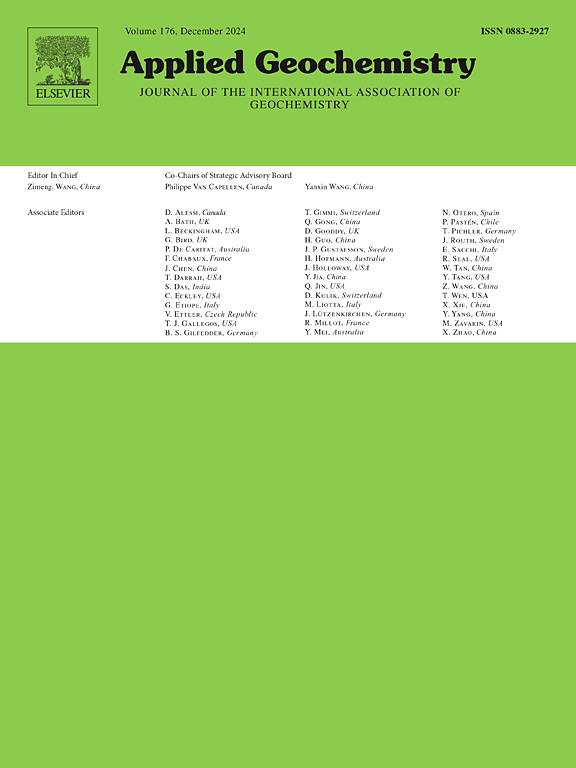Hydrochemistry and stable isotopes of the Ili River: Deciphering spatiotemporal moisture sources and climatic drivers in Central Asia's wet island
IF 3.4
3区 地球科学
Q1 GEOCHEMISTRY & GEOPHYSICS
引用次数: 0
Abstract
The Ili Valley in northwestern China plays a vital role as a green oasis in the large-scale moisture cycle and water utilization in Central Asia's core. To clarify the distinctive hydrochemical characteristics and genesis that differentiate it from the neighboring arid areas, the first large-scale sampling of river water covering the entire Ili Valley was conducted. The results show that the hydrochemical and stable isotopic characteristics vary spatially and seasonally among the tributaries. Rock weathering mainly controls the major ion composition in river water, which gradually varies along the river due to evaporation and snowmelt. The δ2H and δ18O values range from −103.00‰ to −72.00‰ and −15.00‰ to −9.60‰, respectively. Contrary to what is expected, the δ2H & δ18O in the Tekes & Ili Rivers are enriched with altitude, showing an “inverse altitude effect" influenced by topography and moisture sources; the Karsh River has lower δ18O values due to snowmelt; the Kunes River has a U-shaped trend of isotopic concentrations and high d-excess values by precipitation. Both the seasonal deviations in river waterlines (RWL1 vs RWL2) and the backward trajectory by HYSPLIT 4.0 showed that the origin of spring moisture at low troposphere in the Ili Valley could be traced to the surrounding regions, the summer moisture mixed with frigid air from the Arctic Ocean, while sub-cloud evaporation and surface-groundwater interaction are also the factor internally within the basin. The findings complement the basin-scale hydrochemical monitoring data and help investigate the large-scale hydrological cycle.

伊利河的水化学和稳定同位素:中亚湿岛的时空水分来源和气候驱动因素
中国西北伊犁河谷作为绿洲,在中亚大尺度水分循环和水分利用中起着至关重要的作用。为明确伊犁河谷不同于邻近干旱区的水化学特征及其成因,对整个伊犁河谷进行了首次大尺度采样。结果表明,各支流的水化学特征和稳定同位素特征存在空间和季节差异。岩石风化主要控制着河水中的主要离子组成,由于蒸发和融雪的作用,河水中的主要离子组成沿河流逐渐变化。δ2H值为−103.00‰~−72.00‰,δ18O值为−15.00‰~−9.60‰。与预期相反,δ2H &;Tekes的δ18O;伊犁河流高度富集,表现出受地形和水汽源影响的“逆高度效应”;Karsh河的δ18O值因融雪而降低;库内斯河同位素浓度呈u型变化趋势,降水对d的过量影响较大。河流水线(RWL1 vs RWL2)的季节偏差和HYSPLIT 4.0的反演轨迹都表明,伊尔伊尔河谷春季对流层低层水汽的来源可以追溯到周边地区,夏季水汽与北冰洋冷空气混合,而云下蒸发和地表水-地下水相互作用也是盆地内部的因素。这些发现补充了流域尺度的水化学监测数据,有助于研究大尺度的水文循环。
本文章由计算机程序翻译,如有差异,请以英文原文为准。
求助全文
约1分钟内获得全文
求助全文
来源期刊

Applied Geochemistry
地学-地球化学与地球物理
CiteScore
6.10
自引率
8.80%
发文量
272
审稿时长
65 days
期刊介绍:
Applied Geochemistry is an international journal devoted to publication of original research papers, rapid research communications and selected review papers in geochemistry and urban geochemistry which have some practical application to an aspect of human endeavour, such as the preservation of the environment, health, waste disposal and the search for resources. Papers on applications of inorganic, organic and isotope geochemistry and geochemical processes are therefore welcome provided they meet the main criterion. Spatial and temporal monitoring case studies are only of interest to our international readership if they present new ideas of broad application.
Topics covered include: (1) Environmental geochemistry (including natural and anthropogenic aspects, and protection and remediation strategies); (2) Hydrogeochemistry (surface and groundwater); (3) Medical (urban) geochemistry; (4) The search for energy resources (in particular unconventional oil and gas or emerging metal resources); (5) Energy exploitation (in particular geothermal energy and CCS); (6) Upgrading of energy and mineral resources where there is a direct geochemical application; and (7) Waste disposal, including nuclear waste disposal.
 求助内容:
求助内容: 应助结果提醒方式:
应助结果提醒方式:


